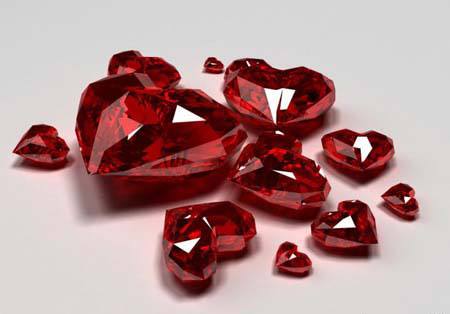The cut of the gem gives it a second life. The quality of the cut directly affects its first visual effect. How is the cut of ruby ​​graded?
Ruby cut: including the orientation, type, proportion, symmetry, and degree of polishing of the cut.
Direction of cut: The mineral crystals of red sapphire are generally barrel, column and plate, as shown in the figure above. The vertical direction of the mineral crystal of red sapphire is called the C axis. It is assumed that a faceted gemstone can be cut into facet X and facet Z, where the table top of X is perpendicular to the C axis, and the table top of Z is parallel to the C axis. From the image on the right, we can see the difference between facet X and facet Z: facet Z obviously has dichroism. Therefore, we should try to make the stone surface of the gemstone perpendicular to the C axis when cutting the rough stone, because the value of the gemstone without dichroism is significantly higher than that of the gemstone with dichroism.

Type of cut: Red sapphire cuts include faceted gemstones and plain gemstones, the basic shape of which is shown below. Larger particles of red sapphire are generally mixed cut. Usually, the crown is cut with a bright shape, which makes the gem show a fascinating anti-fire. The pavilion adopts a trapezoidal cut, which makes the gem take care and gains more. Good color.
The proportion and symmetry of the cut: the color of the red sapphire is the embodiment of its value. In order to achieve bright colors, the cutting angle of the red sapphire does not have a qualitative statement, but the following questions will indeed cut the proportion of red sapphire cut. And symmetry cause no small negative effects:
Obvious asymmetry: Although the asymmetry of red sapphire is inevitable, the obvious asymmetry can seriously affect the light of red sapphire.
Bottom eccentricity: Severe deviation of the facet from the center will affect the uniform reflection of light from the pavilion, and will also adversely affect the anti-fire of red sapphire.
The pavilion is too deep: some lighter faceted red sapphire pavilions are usually cut deeper to deepen the color of the gemstone, which is understandable. However, some darker gems adopt this cutting method in order to take care of themselves, but have a greater impact on the color, and in most cases the price of the gems is calculated by multiplying the weight by the unit price per carat. Therefore, when considering the price of precious stones, you should also consider their pavilion depth.
The pavilion is too thin: too thin pavilion will make the light enter the gemstone and cannot be reflected out, thus forming a larger window area, which is also known as "light leakage", which will also have a greater value for red sapphire. Impact.
Polishing degree: The degree of polishing affects the luster and anti-fire of red sapphire, so it is also an indispensable factor in the evaluation of cutting.
kaiyue , https://www.marketuniongroups.com